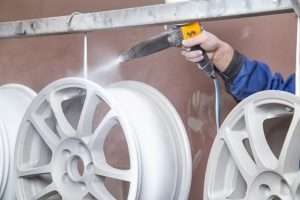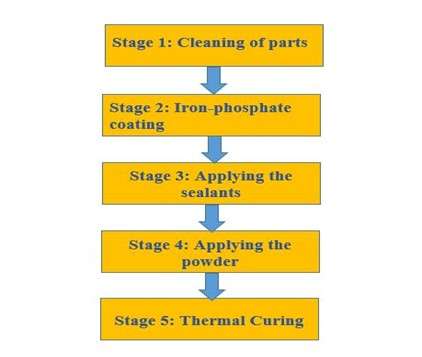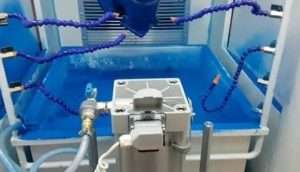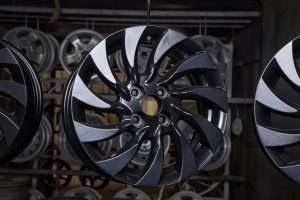Almost every CNC-machined part requires post-processing depending on the intended uses, like surface finishing and lubrication.
Surface finishing involves altering the surface roughness by adding, removing, or reshaping the material. It is not only associated with aesthetic beauty but also with the functionality and durability of parts. There are various surface finishing approaches; deburring, plating, powder coating, painting, and bead blasting.
The selection of these surface finishing techniques depends on the type of material, desired specification, cost, and many other factors. However, this article will focus on the powder coating finish, including stages, advantages, disadvantages, applications, and essential tips.
What is a Powder Coating Finish?

Powder coating finish
Powder coating is the process of applying dry powder on the surface of metallic or non-metallic parts electrostatically. The parts are subjected to coating powder tanks or spraying guns and later treated with intense heat. There is no liquid carrier used to cover the surface with powder. It offers a durable, smooth finish that lasts for a long time.
TGIC Polyester and Urethane Polyester are the two most common powders used in powder coating finishes. These powders provide excellent smoothness along with high wear resistance and durability.
Some other coating materials (powder) include epoxy, polyester, nylon, Polyurethane, and metallic.
|
Epoxy |
Epoxy is highly adhesive, which provides a uniform & smooth coating that lasts for an extended period. These are chemical resistive, corrosion resistive, and withstand a considerable amount of UV exposure. Epoxy coatings are generally applicable for indoor applications. |
|
Polyester |
Polyesters are known for their after-finish glow. They are highly resistant to UV rays and maintain their luster. Despite being less resistant to chemicals, they are an excellent choice for outdoor applications. |
|
Nylon |
Nylon powders offer superior defense against chemicals and oils. It is a good choice for industrial applications where wear and tear is a significant issue. |
|
Polyurethane |
Polyurethane can withstand any weather condition and moisture without any degradation. It is also safe to use for chemical and oil applications. |
|
Metallic |
In most cases, metallic powders are not applied independently. These are mixed with other coating powders to enhance the visual appearance. |
Stages Involved in Powder Coating Finish
To accomplish the powder coating, you need to go through several steps. Let’s discuss each step in detail.

Power coating stage
Stage 1: Cleaning of parts
The powder coating process starts with the thorough cleaning of parts. The ultimate purpose of cleaning involves removing dust, burrs, rust, oils, and any other surface contamination. It can be done with acidic cleansing. But, it must be followed by cleaning with alkalies and pure water rinses. The pieces must next undergo a dry process. The coating can peel off or adhere poorly if any dirt or pollution remains on the surface.
Stage 2: Iron-phosphate coating
To enhance the quality of bonding between surface and powder, a pre-coating of iron phosphate can be very beneficial. In this step, cleaned parts are subjected to phosphate conversion coating. It also minimizes oxidation in case of final product scratching. After the iron this pre-coating, parts need to clean again and dried to proceed with the next stage,
Stage 3: Applying the sealants
Sealants are the adhesive for the powder coating operation. After applying the sealant, you must dry and ensure the surface is entirely free from contamination.
Stage 4: Applying the powder
The powder is implemented in the fourth step after the first three. There are four ways of applying powder on the part’s surface.
- The fluidized bed approach

Fluidize-bed for powder coating
The parts are firstly heated slightly above room temperature and dipped into the fluidized bed containing the powder. Pre-heating helps to attach to the surface effectively. It is suitable for non-metallic and thermoplastic coatings.
- Electrostatic spraying
This approach involves using a spray gun, which sprays the powder on the surface at a medium speed of 170-200 g/min. The distance between them needs to maintain at approximately 20 cm (Technical requirements for electrostatic powder coating, 2020).
A diffused cloud of powder is released from the gun. The positive charge on the powder makes it stick to the grounded surface since it is paired with an electrical field charge produced by a low-amperage power source.
Stage 5: Thermal Curing
Thermal curing is the last stage of the powder coating operation. The coated parts are heated at about 160 to 210 C for 10 to 20 minutes (Can you use a heat gun to cure powder coating? 2021). However, the time might go up depending on the substrate size. Curing ovens are used for heating and work as our kitchen oven.
The heating of parts partially melts the attached powder and sticks strongly. Finally, it forms the hard, tough, and durable layer on the surface.
Advantages of Powder Coating
Choosing the powder coating finish has several benefits in aspects of color flexibility to durability. The main advantages are the followings.
Zero wastage
Electromagnetic energy ensures zero wastage of powder in the coating process. Next, coating many substrates is carried out at once, saving time and money.
Wide range of choices
There are many options of powders, from epoxy and Polyurethane to metallic. It provides a large pool of options, and the appropriate powder can be chosen according to the finishing requirements. Additionally, any texture, color, and finish can be easily customized with the combination of these powders.
Durability
Powder-coated parts become highly resistant to weather, moisture, Uv-rays, chemicals, and other harsh environments and last for an extensive period. Therefore, durability is one of the significant benefits that powder coating offers. It prevents the wear and tear of the parts and contributes to the lifespan of products.
Safe & environmentally friendly
Comparing the powder coating with a traditional painting finish, it is safer & environmentally friendly. Powders do not contain any harmful substances and do not emit any harmful gases while exposed to heat and sunlight. These characteristics render this method of surface finishing free from any poisonous and harmful emissions, making it a pollution-free approach.
Cost-effective
Powder coating is a cost-effective surface finishing method due to its low energy cost, inadequate disposal cost, lesser chance of defective items, and rapid turnaround. Less need for raw materials and equipment is one of the other reasons.
Quality finish
Powder coating provides uniform color throughout the surface of substrates and allows consistency while applying to a large volume of parts. In the long run, it is simple to maintain while the coating eventually peels off.
Disadvantages of Powder Coating Finish
The main disadvantage of powder coating finishes is the difficulty obtaining thin coating layers (< 25 μm), while other approaches like wet painting can easily achieve this. Some of the other disadvantages are;
- The combination of different powders might not result in the intended colors. It is challenging to control the outcomes of combinations.
- Compared to painting, it needs more equipment and results in a moderate installation cost.
- It is challenging to coat non-metallic parts.
- It might not be easy to get multi-color finishing with a powder coating.
Tips to Obtain Quality Powder Coating
Simple considerations can heavily influence the final quality of the powder coating finish. Following are some crucial tips that you can follow to get better results.
- Know the composition of powder, such as which elements are contained in the powder.
- Avoid aiming the spraying gun at the sharp edges, which can result in uniformity of coating.
- Check the tip of the spraying gun regularly to ensure no air build-up.
- Maintain the high adhesiveness of powder coating, which can be ensured by the cross-hatch adhesion test (Crosshatch Adhesion Test, 2017).
- Maintain a suitable distance between the spraying gun and substrate (approximately 20 cm).
Applications of Powder Coating Finish

Part with powder coating finish
Powder coating allows manufacturers to achieve a specific color match that resists corrosion, weather, moisture, and chemicals for an extended period. Therefore, it is suitable for various applications, from furniture to automotive & aerospace parts.
| Industry |
Applications |
| Automotive | Interior parts, wheels, radiators, mirror brackets, shock absorbers, battery trays, braking systems, coil springs, motorbike frames, bicycles, snowmobiles, etc. |
| Electrical & electronics | Lighting fixtures, desktops enclosures, switch gears, HVAC components, water heaters, motor housing, AC cabinets, BBQ grills, garden tools, etc. |
| Home appliances | Microwave cabinets, freezers, Dishwasher racks, patio furniture, fire extinguishers, and parts of many more appliances. |
| Agriculture | Tractor body & parts, cranes, plows, and more. |
| Construction & architecture | Metal roof, bathroom scales, curtain walls, light poles, posts, signs, etc. |
| Sports | Golf carts, ski poles, exercise equipment, and more |
| Hardware & Plumbing | Pipes, taps, storage systems, sanitary parts, etc. |
Conclusion
Powder coating finishing is one of the most effective and suitable options for CNC machined or sheet metal fabricated parts. It is a low-cost approach which provides a long life span for components or products by preventing corrosion, wear, and scratches.
It is essential to follow every stage using advanced equipment to obtain quality powder coating that lasts for several years. At ProleanTech, we offer professional powder coating services for your metallic parts along with other surface finishing options. Our expert engineers ensure high-quality adhesion through pre-treatment processes, and actual coating is done with cutting-edge technologies. Please send us your design; our team is ready to meet your expectations.
FAQ’s
Why should I choose powder coating over painting finish?
Powder coating ensures a highly adhesive finish because of the thermal curing. It provides better resistance to corrosion, UV rays, moisture, and scratching. Furthermore, it lasts for more time than painting.
What is the lifespan of the powder coating finish?
The powder coating can last for up to 20 years. However, various factors define how long it will last, such as powder material, UV exposure, heat exposure, type of application, part material, the thickness of the coating, and many more.
What kinds of materials are suitable for powder coating finishing?
Powder coating is mainly applied for metallic parts, including steel, aluminum, brass, iron, and many others. It applies to plastics, but it requires specific considerations. The problem is parts should be heated up to 400 F during the thermal cure stage.
What are the applications of powder coating finishes?
Powder coating finishes have a wide range of finishes, including automotive parts, architecture & construction, electronics parts, hardware & plumbing, sports, agriculture, and many more.
What is a powder-coated finish?
A dry finishing process where finely ground paint is electrostatically applied and baked on, creating a tough, uniform, and durable coating.
Is powder coating matt or gloss?
Powder coating is available in both matt and gloss finishes—you simply pick your preferred texture.
Does powder coating have a smooth finish?
Yes. Once cured, it forms a consistently smooth, even surface that resists chipping and scratching.
What are the downsides of powder coating?
– Limited colour-match touch-ups (you can’t easily spot-repair scratches).
– Coating thickness can be higher than liquid paint, which may need extra clearance.
– Fewer super-thin or transparent finishes compared to some liquid paints.
How long does powder coating last?
With proper surface prep and normal use, expect 10–20 years of outdoor corrosion resistance (often longer indoors).
How expensive is powder coating?
Typically around $50–$150 per square foot of surface area, depending on part size, colour choice, and any custom prep work.
Bibliography
(2021). Can you use a heat gun to cure powder coating? from https://home.howstuffworks.com/.
(2017). Crosshatch Adhesion Test. corrosionpedia, from https://www.corrosionpedia.com/.
(2020). Technical requirements for electrostatic powder coating. HANNA Manufacture.




0 Comments